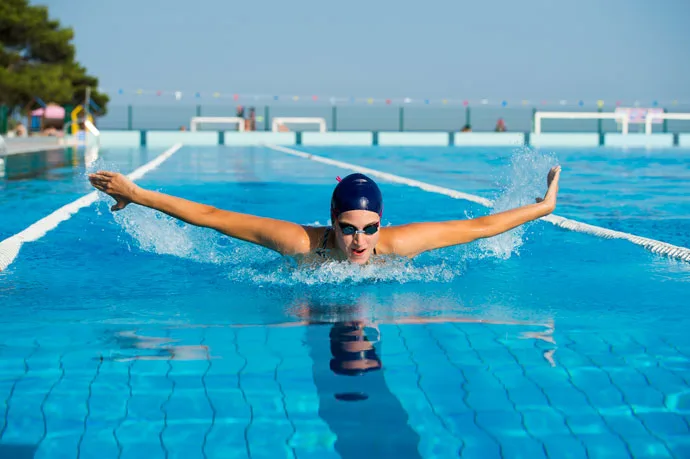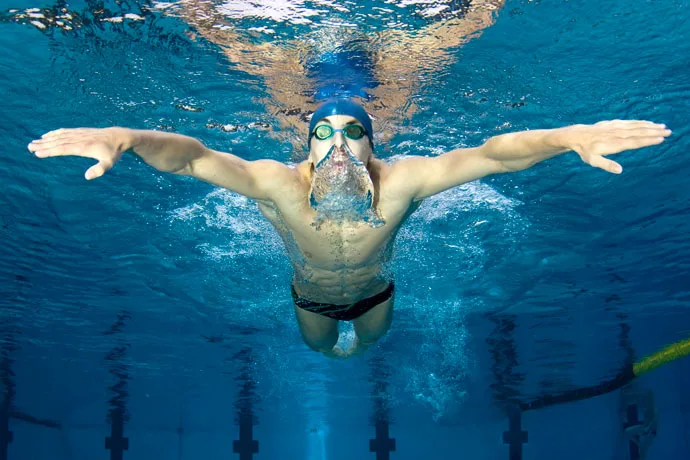Breathing while swimming butterfly is rather straightforward. Nevertheless, there are some subtleties to consider, which are explained in this article.
Inhalation
Inhalation occurs during the upsweep phase and the beginning of the recovery phase of the arms.
To prepare for the inhalation, the head, shoulders and arms are lifted above the water’s surface, using a slightly stronger second dolphin kick. Once the mouth is above water, inhalation can begin.

The upper body is in a forward inclined position when inhaling. To keep the head in a neutral position to avoid straining the neck, the swimmer should look down and slightly forward when inhaling.
Inhalation should be smoothly integrated into the undulating movement of the body; swimmers should not slow down or freeze their movements.
Exhalation
Exhalation begins during the second half of the arm recovery forward when the head and upper body sink back into the water.
The swimmer should exhale continuously in the water until the next breathing stroke cycle.

At the beginning of the next breathing stroke cycle, the remaining air is exhaled in a short burst as the head, shoulders and torso are lifted above the water’s surface again.
Lateral breathing
Butterfly swimmers usually breathe with the head facing downward and slightly forward, as described above. Using lateral breathing, as in the front crawl, is an alternative, as lateral breathing allows the head to be held closer to the water, and less effort is required to lift the head, shoulders and torso above the water.
Likewise, the hips remain closer to the water surface, and the body undulation remains more fluid.
On the other hand, if the head is held in the more traditional downward/forward position, the amplitude of the body undulation is somewhat greater. However, this is not necessarily a bad thing, as this greater body undulation can be converted into greater forward thrust and speed.
The body is prone while swimming the butterfly and can only be turned sideways to a certain degree. Consequently, breathing in from the side is more difficult than in the front crawl and can strain the neck.
Another problem is that with lateral breathing, the symmetry of the stroke suffers and can be less efficient.
For these reasons, the swimmer should experiment with lateral breathing to see if it makes sense or not.
Breathing patterns
In most cases, butterfly swimmers do not inhale on each stroke cycle.
This is explained by the fact that breathing stroke cycles imply lifting the head and upper body above the water’s surface, which requires additional effort. As a result, the swimmer tires more quickly and loses some speed.
On the other hand, in a non-breathing stroke cycle, the effort required is smaller, but the oxygen supply is limited, which may cause the swimmer to get out of breath more quickly.
Therefore, it makes sense to alternate breathing and non-breathing stroke cycles in a pattern that depends on both the swimmer and the swim distance.
The swimmer can get by with fewer inhalations and perhaps even no inhalations at all for short swim distances. On the other hand, longer distances will inevitably require more breathing stroke cycles.
Therefore, swimmers should experiment with different breathing patterns to find out what works for them at different race distances.
For beginners and fitness swimmers, it usually makes the most sense to alternate breathing and non-breathing swim cycles. This is called a 1-and-1 breathing pattern.
Reference
Maglischo, E. (2003). Swimming Fastest. Champaign, IL: Human Kinetics, pp. 167-170.
Related Pages
You may also be interested in the following articles that cover the butterfly stroke’s swimming technique:

Han
Saturday 15th of June 2019
I found your website really helpful. Very simple explanations to each stroke. Technical but look very efficient. Even better than many Youtube videos where we expect to look and copy.!
Christophe
Saturday 15th of June 2019
Thanks a lot!